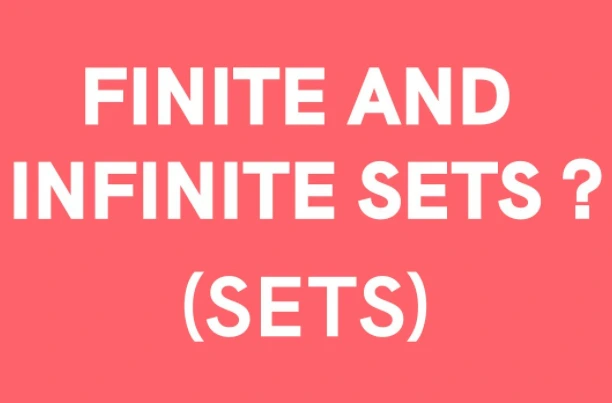In Mathematics, were you ever confused about Infinite and Finite Sets? So, here in this article, we will solve your doubts regarding Finite and Infinite sets properties and discuss the Explanation and Solved examples related to our topic.
Finite Sets and Infinite Sets

Keep reading this article, here we are with the best and exact solution and explanation of your doubts. Before discussing Finite sets and Infinite sets, let us understand what they are.
What are Sets?
In Mathematics, the collection of well-defined objects or elements are called Sets. Sets do not change from person to person. The Capital alphabet represents a set. The number of features or things in infinite sets is known as the cardinal number of a group.
Let us take an example:
M = {1, 2, 3, 4, 5, 6 }
Here, M is the set, and 1, 2, 3, 4, 5, 6 are the members of the set. The members of the set can be in any order, but repeated elements are not allowed. Alphabets are represented by small letters as the members of the set.
Following are the commonly used sets.
- N: Set of all natural numbers.
- Q: Set of all rational numbers.
- R: Set of all real numbers.
- Z: Set of all integers.
- Z+: Set of all positive integers.
Finite Sets
The set of all countable numbers of elements is known as the “Finite Set”. The Finite set is represented by the finite number of elements or members of the set. Remember that all finite sets are countable in the Finite set, but all countable sets are not finite.
In a simple word, you can say that any set with some finite or countable number of elements is a Finite set, and those that don’t have the countable number of elements are not Finite sets.
For example, consider the set of all odd numbers less than 10.
A = {1, 3, 5, 7, 9}
In the above example, we can notice that set A contains 5 elements, which is countable, and that’s why set A is a Finite set.
Properties of a Finite Set
Now we know about Finite Sets, Let’s have a look at the following properties of Finite sets.
- The proper subset of a finite set is also finite.
- The Union of two Finite sets is always finite.
- The intersection of two finite sets is always finite.
- The Cartesian product of finite sets results in finite.
- The power set of a finite set resolves in finite.
- The cardinality of a finite set is finite, equal to the number of objects in the set.
Examples
Let’s take some examples which proves the properties of the Finite set,
M = {1, 2, 3, 4, 5}
N = {2, 4, 6, 8, 10}
O = {2, 3)
- The M, N, O sets are finite.
Because the elements in them are countable and finite.
- O ⊂ M, i.e., O is a Subset of M because all the elements of set O are present in M.
Here we can say that the subset of a finite set is always finite.
- M U N is { 1, 2, 3, 4, 5, 6, 8, 10}.
So, the union of two finite sets are also finite.
Infinite Set
The major difference between infinite and finite sets is the number of elements in their sets. The Infinite set is the set that contains an infinite number of elements. The set of all uncountable number of elements is known as “Infinite Set”.
And if we talk about infinite sets, they are called uncountable sets.
For example, consider the set of all Whole numbers.
W = {0, 1, 2, 3, 4, 5,}
In the above example, we wanted you to observe that whole numbers are not limited. We consider all whole numbers, which mean from 0 to infinite because we cannot count the total whole numbers. That is why we consider the set W is an Infinite set.
All about Infinite Sets
Let’s have a look at some essential properties of the Infinite set.
- The union of infinite sets is also an infinite set.
- The power set of an infinite set also results in infinite.
- The superset of an infinite set is infinite.
- A subset of an infinite set might be infinite or may not be infinite.
- Infinite sets may or may not be uncountable. For example, the set of real numbers is uncountable, and the set of integers is countable.
Examples
Let’s take some examples which proves the properties of Infinite set,
All the Whole numbers W = {0, 1, 2, 3, 4,}
All Even numbers presented here N = {2, 4, 6, 8, 10,}
- The W, N sets are infinite.
Because the elements in them are uncountable and infinite.
- W U N is { 0, 1, 2, 3, 4, 5, 6, 8, 10, 11,}.
So, the union of two infinite sets is also infinite.
How to identify if it is a Finite or Infinite Set?
Now we know the definition of Infinite and Finite sets, but how to tell whether the set we have is Finite or Infinite. To understand, we know that if a set has a countable number of Finite elements, also you can say if a set in itself has an ending point and a starting point, it is a Finite set.
And if a set has an uncountable number of elements or does not have a starting and an ending point is an Infinite set.
Following are some important points to identify a set is either finite or infinite.
- If we talk about an infinite side, it is endless from the ending or the starting, but both the sides can have continuity, and like that is given out in finite sets.
- If a set has the countable elements, then the set is Finite, whereas if it has an uncountable number of elements, it is an Infinite set.
Conclusion
To conclude, we would like to highlight that there are 4 kinds of sets that we should know about.
- Finite sets.
- Equal or equivalent sets.
- Infinite sets.
- Null Set.
Knowing about the above completes your lesson on Sets and will make you remarkable in this portion of knowledge. We covered what infinite and finite sets are efficiently!
Join 25,000+ smart readers—don’t miss out!







